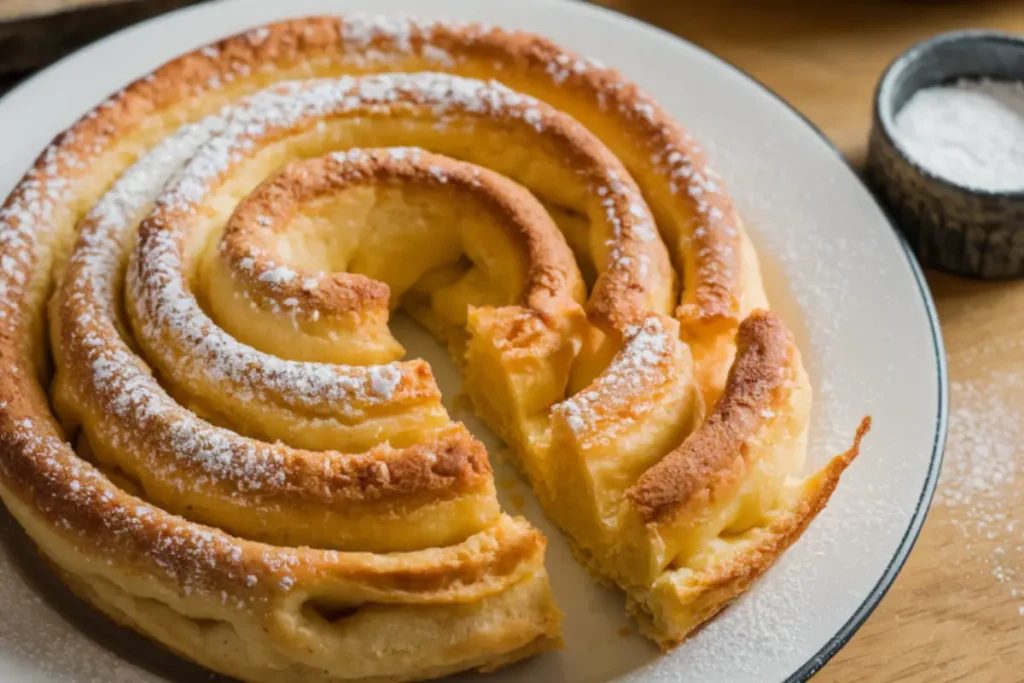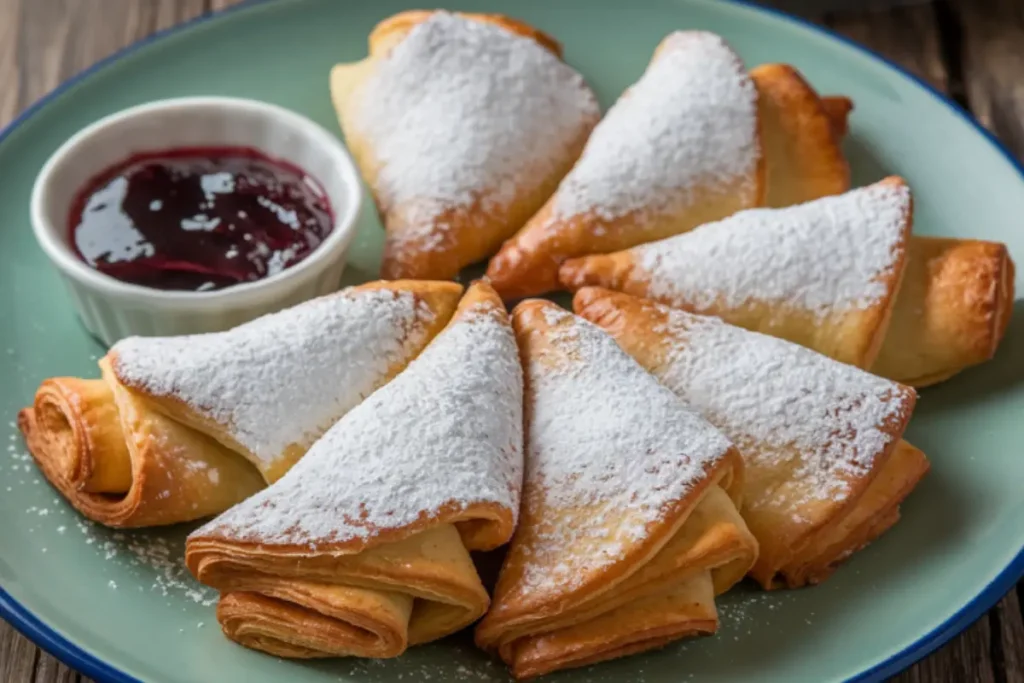Gipfeli, the Swiss counterpart to the French croissant, is a beloved pastry that’s both flaky and buttery. Originating in Switzerland, the Gipfeli Recipe has become a breakfast staple, cherished for its rich flavor and delicate layers. Whether enjoyed as a morning treat or a mid-day snack, this Gipfeli Recipe allows you to create homemade Gipfeli that capture the essence of Swiss baking. In this guide, you’ll discover how to make Gipfeli from scratch, explore its variations, and learn tips to perfect your technique.
History of Gipfeli
Gipfeli has deep roots in Swiss culture, often compared to the French croissant. While both pastries share similarities, Gipfeli is distinct in its denser texture and less sweet flavor profile. Originating in Switzerland, Gipfeli quickly became a staple in Swiss households and cafés, known for its simplicity and ease of baking at home. The Gipfeli recipe reflects this tradition, making it accessible for home bakers to recreate this beloved pastry. Moreover, its cultural significance extends beyond the borders of Switzerland, symbolizing the country’s culinary heritage.
Key Differences Between Gipfeli and Croissants
Although Gipfeli and croissants might look similar, there are key differences:
- Texture: Gipfeli are typically denser and have a richer, more buttery flavor compared to the light and airy croissant. Furthermore, the layers in a Gipfeli are less pronounced, contributing to its unique texture.
- Shape: Unlike the traditional crescent shape of croissants, Gipfeli are more compact, making them easier to handle and bake uniformly.
- Flavor: Gipfeli is less sweet and often contains a hint of milk, enhancing its richness. In contrast, croissants tend to be lighter and slightly sweeter, making them more versatile for various fillings.
Essential Ingredients for Gipfeli Recipe
To create authentic Gipfeli, you’ll need high-quality ingredients. Here’s what you need:
- Flour: A mix of all-purpose and bread flour works best, providing strength and tenderness to the dough.
- Butter: Use cold, high-fat butter for the best lamination and flavor. Without a doubt, the quality of butter directly impacts the flakiness of the Gipfeli.
- Milk: Whole milk adds richness and a slight sweetness, which complements the buttery flavor.
- Yeast: Choose between active dry yeast or instant yeast, depending on your preference.
- Sugar and Salt: These enhance the flavor and help in the fermentation process.
Step-by-Step
 Making Gipfeli involves several steps, from preparing the dough to laminating and baking. Here’s a comprehensive guide to help you through each stage:
Making Gipfeli involves several steps, from preparing the dough to laminating and baking. Here’s a comprehensive guide to help you through each stage:
Preparing the Dough
- Mix Ingredients: In a large mixing bowl, combine 4 cups of all-purpose flour, 2 tsp of active yeast, 4 tbsp of sugar, and 2 tsp of salt.
- Add Wet Ingredients: Gradually add 1 cup of warm milk and 3 tbsp of melted butter, mixing until a soft dough forms.
- Knead the Dough: Knead the dough on a lightly floured surface until it becomes smooth and elastic. This process usually takes about 10 minutes. As a result, the dough should be able to stretch without tearing.
- Rest the Dough: Place the dough in a greased bowl, cover it with a clean towel, and let it rise in a warm place for about 1 hour or until it doubles in size.
Laminating the Dough
- Prepare the Butter: Roll out 2 sticks of cold butter between two sheets of parchment paper into a 1 cm thick rectangle. Refrigerate until needed.
- Roll the Dough: After the dough has risen, roll it into a rectangle about 1 cm thick.
- Layer the Butter: Place the butter on one half of the dough and fold the other half over, sealing the edges.
- First Fold: Roll the dough out again and fold it into thirds, like a letter. Rotate the dough 90 degrees and repeat this folding process twice more.
- Chill the Dough: Wrap the dough in plastic wrap and chill it in the refrigerator for at least 1 hour.
Shaping the Gipfeli
- Cut the Dough: Roll the chilled dough into a 5 mm thick rectangle. Next, cut it into triangles with a base of 8 cm and a height of 15 cm.
- Shape the Gipfeli: Starting from the base, roll each triangle towards the tip, forming a crescent shape.
- Final Proofing: Place the shaped Gipfeli on a parchment-lined baking sheet, cover with a damp cloth, and let them rise in a warm place for 30 minutes.
Baking Gipfeli to Perfection
- Preheat the Oven: Set your oven to 200°C (390°F). Additionally, ensure that the oven is properly heated before placing the pastries inside.
- Apply Egg Wash: Mix 1 egg yolk with 1 tbsp of milk and brush over the Gipfeli for a golden finish.
- Bake: Bake the Gipfeli for 15-20 minutes, or until they are golden brown and flaky.
- Cool: Once baked, transfer the Gipfeli to a wire rack to cool slightly before serving.
Troubleshooting Common Gipfeli Problems
Even with careful preparation, issues can arise. Here are solutions to common problems:
- Underproofed Dough: Ensure the dough rises fully; if it’s not doubling in size, give it more time in a warm spot. Alternatively, try placing the dough in a slightly warmer area for better results.
- Overbaked Gipfeli: Check your oven’s temperature accuracy with an oven thermometer and reduce the baking time if necessary.
- Excessive Spread: Chill the shaped Gipfeli before baking to prevent the butter from melting out. Moreover, be sure to handle the dough gently to maintain its structure.
Serving Suggestions for Gipfeli
Gipfeli are versatile and can be enjoyed in various ways:
- Classic Butter: Simply spread with high-quality butter.
- Sweet Toppings: Serve with jam, honey, or a dusting of powdered sugar. This option adds a delightful sweetness that complements the buttery layers.
- Savory Fillings: Pair with cheeses or smoked meats for a hearty snack.
- Dipped in Chocolate: For an indulgent treat, dip half of each Gipfeli in melted chocolate.
Variations of Gipfeli Recipe
Gipfeli can be customized to suit different tastes. In fact, both sweet and savory options can be easily adapted with simple ingredient changes.
Sweet Gipfeli Variations
| Variation | Filling Ingredients |
|---|---|
| Chocolate Gipfeli | Small chocolate pieces |
| Almond Gipfeli | Ground almonds, sugar, milk |
| Raspberry Gipfeli | Raspberry jam |
Savory Gipfeli Variations
| Variation | Filling Ingredients |
|---|---|
| Cheese Gipfeli | Cheese slices |
| Ham and Cheese | Ham slices, cheese slices |
| Spinach and Feta | Cooked spinach, crumbled feta cheese |
You can adapt the Gipfeli recipe to meet various dietary needs:
- Gluten-Free Gipfeli: Use a gluten-free flour blend.
- Vegan Gipfeli: Substitute butter with vegan butter and use almond milk.
- Low-Sugar Version: Reduce or omit the sugar in the dough.
 Global Variations and Fusion Recipes
Global Variations and Fusion Recipes
The Gipfeli recipe has inspired global adaptations, integrating flavors from different cuisines:
- Matcha Gipfeli: Incorporate matcha powder into the dough for a vibrant green hue and a hint of earthy flavor.
- Pesto Gipfeli: Spread a thin layer of pesto before shaping for an herbaceous, savory pastry.
- Spiced Gipfeli: Add cinnamon or cardamom to the dough for a warm, aromatic twist.
Tips for Perfecting Your Gipfeli Technique
Achieving professional-quality Gipfeli requires attention to detail:
- Use Cold Butter: Ensure the butter stays cold throughout the lamination process to maintain the flaky layers.
- Don’t Overwork the Dough: After adding the butter, avoid over-kneading to keep the layers intact.
- Even Rolling: Roll the dough evenly to ensure uniform baking. Additionally, use a ruler to measure thickness if necessary.
- Proper Rising Time: Allow the shaped Gipfeli enough time to rise before baking for a light, airy texture.
Storing and Reheating Gipfeli
To keep your Gipfeli fresh:
- Room Temperature Storage: Store in an airtight container for up to 2 days. However, avoid refrigeration, as it can make the pastry stale.
- Freezing: Wrap each Gipfeli individually in plastic wrap and freeze for up to 3 months.
- Reheating: Warm in an oven at 175°C (350°F) for 5-7 minutes. Avoid microwaving, as it can make the pastry soft.
Gipfeli in Modern Culinary Culture
Gipfeli is more than just a pastry; it’s a cultural icon in Switzerland:
- Swiss Cafés: Gipfeli are a breakfast staple, often enjoyed with coffee in local cafés. Furthermore, Swiss bakers pride themselves on using traditional methods, ensuring each Gipfeli is fresh and delicious.
- Home Baking Trends: With the rise of home baking, Gipfeli has gained popularity among amateur bakers, inspiring countless social media posts and tutorials. Consequently, many home bakers have started experimenting with different flavors and techniques.
- Global Fusion: Chefs around the world are putting their own spin on Gipfeli, incorporating local ingredients and flavors. As a result, you can find unique variations like curry-flavored or matcha-infused Gipfeli in different parts of the world.
Making Gipfeli Ahead of Time
For convenience, Gipfeli can be made in advance:
- Overnight Prep: Prepare the dough and shape the Gipfeli, then refrigerate overnight. Bake fresh the next morning.
- Freezing Dough: Freeze the shaped Gipfeli before the final rise. Thaw at room temperature, let them rise, and then bake as usual. This approach not only saves time but also ensures that your Gipfeli are freshly baked when needed.
FAQs
How is Gipfeli different from a French croissant?
Gipfeli is denser and richer in butter compared to the lighter and flakier French croissant. It also tends to be less sweet, making it suitable for both savory and sweet variations.
Can I freeze the Gipfeli dough?
Yes, Gipfeli dough can be frozen after shaping. Place them on a tray, freeze until solid, then store in a plastic bag. Thaw and let them rise before baking.
What is the best way to reheat Gipfeli?
The best method is to reheat them in an oven at 175°C (350°F) for 5-7 minutes. This helps maintain their crispy exterior. Avoid microwaving as it can make them soft.
Can I make Gipfeli vegan?
Absolutely! Substitute the butter with vegan butter and use a non-dairy milk like almond or soy milk for the dough.
Why is my Gipfeli dough tough?
Tough dough can result from over-kneading or not allowing the dough to rest enough. Make sure to give the dough time to relax between kneading and shaping.
What can I serve with Gipfeli?
Gipfeli pairs wonderfully with butter, jams, honey, cheeses, and even chocolate. They are versatile and can complement both sweet and savory spreads.

Conclusion
Making Gipfeli at home allows you to enjoy this Swiss classic fresh and warm, straight from your oven. With the right ingredients and techniques, you can achieve the perfect flaky, buttery layers that make Gipfeli so delightful. Whether you’re a seasoned baker or a beginner, this guide provides everything you need to master Gipfeli and even explore variations to suit your tastes. For additional tips, check out this helpful discussion on perfecting pastry techniques.

 Global Variations and Fusion Recipes
Global Variations and Fusion Recipes